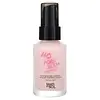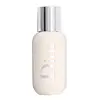What's inside
What's inside
 Key Ingredients
Key Ingredients

 Benefits
Benefits

 Concerns
Concerns

 Ingredients Side-by-side
Ingredients Side-by-side

Cyclopentasiloxane
EmollientWater
Skin ConditioningDimethicone
EmollientDimethicone/Vinyl Dimethicone Crosspolymer
Skin ConditioningPEG-10 Dimethicone
Skin ConditioningDimethicone Crosspolymer
Emulsion StabilisingDipropylene Glycol
HumectantSilica
AbrasivePhenoxyethanol
PreservativeDisteardimonium Hectorite
StabilisingMagnesium Sulfate
Parfum
MaskingMethyl Methacrylate Crosspolymer
CI 77891
Cosmetic ColorantEthylhexylglycerin
Skin ConditioningDisodium EDTA
Aluminum Hydroxide
EmollientStearic Acid
CleansingButylene Glycol
HumectantCI 77491
Cosmetic ColorantSoluble Collagen
HumectantCI 73360
Cosmetic ColorantCamellia Sinensis Leaf Extract
AntimicrobialTriethoxycaprylylsilane
Cyclopentasiloxane, Water, Dimethicone, Dimethicone/Vinyl Dimethicone Crosspolymer, PEG-10 Dimethicone, Dimethicone Crosspolymer, Dipropylene Glycol, Silica, Phenoxyethanol, Disteardimonium Hectorite, Magnesium Sulfate, Parfum, Methyl Methacrylate Crosspolymer, CI 77891, Ethylhexylglycerin, Disodium EDTA, Aluminum Hydroxide, Stearic Acid, Butylene Glycol, CI 77491, Soluble Collagen, CI 73360, Camellia Sinensis Leaf Extract, Triethoxycaprylylsilane
Water
Skin ConditioningIsododecane
EmollientGlycerin
HumectantCyclopentasiloxane
EmollientPolysilicone-11
Butyrospermum Parkii Butter
Skin ConditioningPolymethylsilsesquioxane
PEG-9 Polydimethylsiloxyethyl Dimethicone
EmulsifyingMethyl Methacrylate Crosspolymer
Synthetic Fluorphlogopite
Phenoxyethanol
PreservativeCaprylyl Glycol
EmollientMagnesium Sulfate
Sorbitan Sesquioleate
EmulsifyingDisteardimonium Hectorite
StabilisingParfum
MaskingPropylene Carbonate
SolventMalva Sylvestris Extract
AstringentTocopherol
AntioxidantHydrogen Dimethicone
Linalool
PerfumingCitric Acid
BufferingLimonene
PerfumingCitronellol
PerfumingBHT
AntioxidantCI 19140
Cosmetic ColorantCI 42090
Cosmetic ColorantCI 77007
Cosmetic ColorantCI 77163
Cosmetic ColorantIron Oxides
CI 77891
Cosmetic ColorantWater, Isododecane, Glycerin, Cyclopentasiloxane, Polysilicone-11, Butyrospermum Parkii Butter, Polymethylsilsesquioxane, PEG-9 Polydimethylsiloxyethyl Dimethicone, Methyl Methacrylate Crosspolymer, Synthetic Fluorphlogopite, Phenoxyethanol, Caprylyl Glycol, Magnesium Sulfate, Sorbitan Sesquioleate, Disteardimonium Hectorite, Parfum, Propylene Carbonate, Malva Sylvestris Extract, Tocopherol, Hydrogen Dimethicone, Linalool, Citric Acid, Limonene, Citronellol, BHT, CI 19140, CI 42090, CI 77007, CI 77163, Iron Oxides, CI 77891
Ingredients Explained
These ingredients are found in both products.
Ingredients higher up in an ingredient list are typically present in a larger amount.
Ci 77891 is a white pigment from Titanium dioxide. It is naturally found in minerals such as rutile and ilmenite.
It's main function is to add a white color to cosmetics. It can also be mixed with other colors to create different shades.
Ci 77891 is commonly found in sunscreens due to its ability to block UV rays.
Learn more about CI 77891Cyclopentasiloxane, or D5, is a silicone used to improve texture of products and trap moisture.
D5 is considered lightweight and volatile. Volatile means it evaporates quickly after application. Once evaporated, D5 leaves a thin barrier that helps keep skin hydrated.
It is also an emollient. Emollients help soften the skin and prevent water loss. Silicones create a silky texture in products. D5 helps other ingredients become more spreadable.
Studies show D5 is safe to use in skincare products. We recommend speaking with a skincare professional if you have concerns.
Learn more about CyclopentasiloxaneDisteardimonium Hectorite comes from the clay mineral named hectorite. It is used to add thickness to a product.
It can also help stabilize a product by helping to disperse other ingredients.
Hectorite is a rare, white clay mineral.
Learn more about Disteardimonium HectoriteMagnesium Sulfate is a salt. More specifically, it is an epsom salt, or the bath salt used to help relieve muscle aches.
Despite having ‘sulfate’ in the name, it isn’t a surfactant or cleansing agent like sodium lauryl sulfate. Unlike those sulfates, magnesium sulfate doesn’t have the same cleansing or foaming properties (it's simply a type of salt).
In cosmetics, Magnesium Sulfate is used to thicken a product or help dilute other solids. It is a non-reactive and non-irritating ingredient.
One study shows magnesium deficiency may lead to inflammation of the skin. Applying magnesium topically may help reduce inflammation.
You can find this ingredient in sea water or mineral deposits.
Learn more about Magnesium SulfateThis ingredient comes as a powder made up of small, porous, microbeads. It is used to add a silky feel to products and also helps absorb oil.
Parfum is a catch-all term for an ingredient or more that is used to give a scent to products.
Also called "fragrance", this ingredient can be a blend of hundreds of chemicals or plant oils. This means every product with "fragrance" or "parfum" in the ingredients list is a different mixture.
For instance, Habanolide is a proprietary trade name for a specific aroma chemical. When used as a fragrance ingredient in cosmetics, most aroma chemicals fall under the broad labeling category of “FRAGRANCE” or “PARFUM” according to EU and US regulations.
The term 'parfum' or 'fragrance' is not regulated in many countries. In many cases, it is up to the brand to define this term.
For instance, many brands choose to label themselves as "fragrance-free" because they are not using synthetic fragrances. However, their products may still contain ingredients such as essential oils that are considered a fragrance by INCI standards.
One example is Calendula flower extract. Calendula is an essential oil that still imparts a scent or 'fragrance'.
Depending on the blend, the ingredients in the mixture can cause allergies and sensitivities on the skin. Some ingredients that are known EU allergens include linalool and citronellol.
Parfum can also be used to mask or cover an unpleasant scent.
The bottom line is: not all fragrances/parfum/ingredients are created equally. If you are worried about fragrances, we recommend taking a closer look at an ingredient. And of course, we always recommend speaking with a professional.
Learn more about ParfumPhenoxyethanol is a preservative that has germicide, antimicrobial, and aromatic properties. Studies show that phenoxyethanol can prevent microbial growth. By itself, it has a scent that is similar to that of a rose.
It's often used in formulations along with Caprylyl Glycol to preserve the shelf life of products.
Water. It's the most common cosmetic ingredient of all. You'll usually see it at the top of ingredient lists, meaning that it makes up the largest part of the product.
So why is it so popular? Water most often acts as a solvent - this means that it helps dissolve other ingredients into the formulation.
You'll also recognize water as that liquid we all need to stay alive. If you see this, drink a glass of water. Stay hydrated!
Learn more about Water